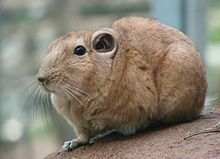Gundi
| Gundi Temporal range: Early Oligocene–Recent |
|
|---|---|
 |
|
| Ctenodactylus gundi | |
| Scientific classification | |
| Kingdom: | Animalia |
| Phylum: | Chordata |
| Class: | Mammalia |
| Order: | Rodentia |
| Suborder: | Hystricomorpha |
| Family: |
Ctenodactylidae Gervais, 1853 |
| Genera | |
 |
|
Ctenodactylus
Felovia
Massoutiera
Pectinator
Gundis or comb rats (family Ctenodactylidae) are a group of small, stocky rodents found in Africa. They live in rocky deserts across the northern parts of the continent. The family comprises four living genera and five species (Speke's gundi, Felou gundi, Val's or desert gundi, common or North African gundi and Mzab gundi), as well as numerous extinct genera and species. They are in the superfamily Ctenodactyloidea. They first came to the notice of western naturalists in Tripoli in 1774, and were given the name 'gundi mice'.
Gundis are from 17–18 cm in body length, with compact bodies covered in soft fur, short legs, and large eyes. They have only four toes on all feet and the middle toes of the hind feet carry comb-like bristles, which earned them the name comb rat. Gundis have short tails, which in some species are covered in a large fan of hair that aids in balancing as they move about their rocky and uneven environments. They are herbivorous, eating almost every type of available plant. Like many other desert animals, they do not drink, obtaining all the moisture they need from their food. Their incisors lack the layer of tough, orange, enamel found in other rodents, and they have a dental formula of:
Females typically give birth to two young at a time, after a gestation period of about two months. Because of the need to preserve moisture, female gundis produce only a small amount of milk, and the young are fully weaned by four weeks of age.
...
Wikipedia
